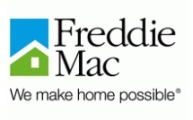Freddie Mac Prices Two STACR Credit Risk Sharing Transactions
MCLEAN, VA--(Marketwired - Oct 23, 2014) - Freddie Mac (
"Credit risk sharing is a top priority at Freddie Mac," said Kevin Palmer, vice president of single-family strategic credit costing and structuring for Freddie Mac. "We are happy to see such strong demand for STACR bonds especially given last week's market volatility."
When these transactions settle, the company will have issued $6 billion of STACR debt notes and obtained insurance coverage through ACIS (Agency Credit Insurance Structure) reinsurance transactions of $631 million since they were launched last year. Through these credit risk transfer transactions, the company will have laid off a substantial portion of the credit risk on $205 billion UPB in single-family mortgages.
STACR Debt Notes, Series 2014-DN4 and Series 2014-HQ3 were offered to the market by Bank of America Merrill Lynch and J.P. Morgan as co-lead managers and joint bookrunners. Citigroup, Deutsche Bank Securities and Wells Fargo Securities served as co-managers, and Bonwick Capital as selling group member. These transactions will be listed on the Global Exchange Market of the Irish Stock Exchange and have indicative regulatory assessment designations from the National Association of Insurance Commissioners.
STACR, Series 2014-DN4
Pricing for the STACR Series 2014-DN4, M-1 class was one-month LIBOR plus a spread of 140 basis points. Pricing for the M-2 class was one month LIBOR plus a spread of 240 basis points. Pricing for the M-3 class was one month LIBOR plus a spread of 455 basis points. The offering is scheduled to settle on or around October 28, 2014.
The Series 2014-DN4, M-1 class has 4.2% subordination and received an investment grade rating of A-sf from Fitch and A1(sf) from Moody's, subject to ongoing monitoring. The M-2 class has 2.9% subordination and received an investment grade rating of BBB-sf from Fitch and A3(sf) from Moody's, subject to ongoing monitoring. The M-3 class was not rated and has .50% subordination. The three classes have an exchangeable feature giving investors the option to either combine pro-rata portions of the cash flows from the M-1, M-2 and M-3 classes or strip off a portion of the interest from any class to create bonds with different margins.
For Series 2014-DN4, the amount of periodic principal and ultimate principal paid by Freddie Mac is determined by the performance of a very large and diversified reference pool of almost 70,000 residential loans, representing an unpaid principal balance of more than $15.7 billion. This pool consists of a subset of 30-year fixed-rate single-family mortgages acquired by Freddie Mac in the first quarter of 2014. Freddie Mac holds the senior risk and the first loss risk in the reference pool, and a portion of the risk in the M-1, M-2 and M-3 classes.
STACR, Series 2014-HQ3
Pricing for the STACR Series 2014-HQ3 M-1 class was one-month LIBOR plus a spread of 165 basis points. Pricing for the M-2 class was one month LIBOR plus a spread of 265 basis points. Pricing for the M-3 class was one month LIBOR plus a spread of 475 basis points. The offering is scheduled to settle on or around October 28, 2014.
The Series 2014-HQ3, M-1 class has 4.75% subordination and received investment grade ratings of A-sf from Fitch and A1(sf) from Moody's, subject to ongoing monitoring. The M-2 class has 3.1% subordination and received investment grade ratings of BBB-sf from Fitch and Baa1(sf) from Moody's, subject to ongoing monitoring. The M-3 class was not rated and has .85% subordination. The M-1, M-2 and M-3 Classes of the Series 2014-HQ3 have an exchangeable feature giving investors the option to either combine pro-rata portions of the cash flows from the M-1, M-2 and M-3 classes or strip off a portion of the interest from any class to create bonds with different margins.
For Series 2014-HQ3, the amount of periodic principal and ultimate principal paid by Freddie Mac is determined by the performance of a very large and diversified reference pool of more than 36,000 residential loans, representing an unpaid principal balance of approximately $8 billion. This pool consists of a subset of 30-year fixed-rate single-family mortgages acquired by Freddie Mac in the first quarter of 2014. Freddie Mac holds the senior risk and the first loss risk in the reference pool, and a portion of the risk in the M-1, M-2 and M-3 classes.
This announcement is not an offer to sell any Freddie Mac securities. Offers for any given security are made only through applicable offering circulars and related supplements, which incorporate Freddie Mac's Annual Report on Form 10-K for the year ended December 31, 2013, filed with the Securities and Exchange Commission (SEC) on February 27, 2014; all other reports Freddie Mac filed with the SEC pursuant to Section 13(a) of the Securities Exchange Act of 1934 (Exchange Act) since December 31, 2013, excluding any information "furnished" to the SEC on Form 8-K; and all documents that Freddie Mac files with the SEC pursuant to Sections 13(a), 13(c) or 14 of the Exchange Act, excluding any information "furnished" to the SEC on Form 8-K.
Freddie Mac's press releases sometimes contain forward-looking statements. A description of factors that could cause actual results to differ materially from the expectations expressed in these and other forward-looking statements can be found in the company's Annual Report on Form 10-K for the year ended December 31, 2013, and its reports on Form 10-Q and Form 8-K, filed with the SEC and available on the Investor Relations page of the company's Web site at www.FreddieMac.com/investors and the SEC's Web site at www.sec.gov.
Freddie Mac was established by Congress in 1970 to provide liquidity, stability and affordability to the nation's residential mortgage markets. Freddie Mac supports communities across the nation by providing mortgage capital to lenders. Today Freddie Mac is making home possible for one in four home borrowers and is one of the largest sources of financing for multifamily housing. Additional information is available at FreddieMac.com, Twitter @FreddieMac and Freddie Mac's blog FreddieMac.com/blog.
